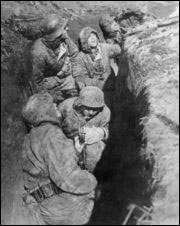Alsace 1945:
Additional
Panzer Reserves
By Mike Bennighof, Ph.D.
August 2017
Germany’s dictator, Adolf Hitler,
appears to have hatched the idea of a massive
armored counter-offensive against the advancing
Western Allies sometime in August 1944. Once
the weather grew poor enough to inhibit the
Allied advantage in air power, up to 40 divisions
would strike at a key point in the line in
hopes of shattering the Western alliance.
By November, the Ardennes region of Luxembourg
and eastern Belgium had been selected as the
target, and up to 40 divisions were said to
be assigned to the attack. Through substantial
efforts, the German Army and Waffen SS re-trained
and re-equipped a number of their armored
formations, but the 40-division target was
never reached.
Other units were diverted to the feint known
as Operation Nordwind, covered in our Alsace
1945 game. Some were locked in combat
on other sectors of the front and never withdrawn
for re-fitting — and the resources for
such an effort, in manpower and equipment,
would have been difficult to find in any case.
And finally there would have been the question
of fuel: if the Germans had somehow diverted
more panzers to Alsace, where would
they have found the gasoline to move them
forward?

Former camp guards of the “Death’s
Head” Division in combat in Hungary,
1945.
|
Nevertheless, gamers like their variants,
and for today’s we’ll look at
the divisions that went into action at the
same time that the Battle of the Bulge was
taking place. The two divisions of the IV
SS Panzer Corps had fought against the Soviets
near Warsaw in the late months of 1944. They
had been in continuous combat for many months
by this point, and were badly worn down. Both
divisions left the line in December and went
to Hungary, receiving fresh drafts of replacements
and new equipment to bring them up to at least
their full paper strength.
These two units, 3rd “Death’s
Head” and 5th “Viking” SS
Panzer Divisions, fought surprisingly well
in western Hungary though they failed to relieve
the siege of Budapest. Hitler’s diversion
of two such divisions to a secondary theater,
while Germany was rolling the iron dice in
Belgium and watching the Red Army roll toward
Berlin, has been rightly criticized as a poor
military decision. And as the Law of Unintended
Consequences proves, other problems flowed
from this move. When the Germans opened an
offensive on the south bank of the Danube,
the Soviets countered with one of their own
on the north bank, aimed at taking the vital
bridge at Komorn.
To hold Komorn and keep the two SS divisions
supplied in their offensive, the Germans had
to commit the Army’s 20th Panzer Division
out of the reserve. This unit had been nearly
destroyed during the Soviet summer offensive,
and by August its remnants were in East Prussia
for re-fitting and re-training. Smaller armored
units were absorbed, replacements and new
equipment assigned, and by winter the division
was considered fit for combat. It was not
assigned to the Ardennes offensive, however,
but instead went to Hungary to defend Komorn.
There is fought very well, holding off the
Soviet 8th Guards Tank Army.

This would have surprised the Americans.
A T-34 of the “Death’s Head”
Division in Hungary, 1945.
|
While the Hungarian operation helped hasten
the end of the Thousand-Year Reich’s
12-year lifespan, there were factors in its
favor. The offensive placed the two initial
assault divisions close to their source of
fuel at a time when gasoline was in short
supply. German ability to transport two mechanized
divisions into the tightly-packed assembly
areas east of the Ardennes, and to handle
the additional burden on their already-stretched
logistics, is also questionable. While the
attack in Hungary sucked in a third full-equipped
panzer division, this unit had not been assigned
to the Ardennes anyway and likely would have
fought somewhere on the Eastern Front against
a Soviet breakthrough.
The divisions withdrawn from the Western
Front in September and October had gone through
a long period of re-training in manuever areas.
This made them much more effective when they
returned to combat; many historians let alone
game designers overlook the need for continual
training, especially by troops and units with
long periods in action. As shown in our old Sinister
Forces book, the Waffen SS was not
so much a branch of the armed forces as a
collection of the armed feudal followers of
various Nazi power centers. The five SS panzer
divisions “favored” with rest
and retraining all had politically powerful
patrons: the Adolf Hitler Life Guards had
their connection to the Nazi leader’s
personal bodyguard; the Reich, Frundsberg
and Hohenstaufen divisions all had their origins
in the original “Special Purpose Troops”
that became the Armed SS, and finally the
Hitler Youth Division sprang from the party’s
youth organization. The “Nordic”
volunteers of Viking and the camp guards of
Death’s Head had either never had a
top-level patron in the former case, or lost
theirs in the latter. Thus the two SS divisions
in our variant are slightly weaker than the
other SS panzer divisions, but the Army division
is quite strong.
As a variant for Alsace
1945, all units of 3rd and 5th SS
Panzer Divisions, the Army’s 20th Panzer
Division and 502nd Heavy Tank Battalion AND
the IV SS headquarters enter play as 25 December
reinforcements in the Wacht am Rhein South
scenario, and as 1 January reinforcements
in the Nordwind scenario.
Victory conditions remain the same in all
scenarios.
You can download
the new pieces for this variant here.
Click
here to buy Alsace 1945 now!
Mike Bennighof is president of Avalanche Press and holds a doctorate in history from Emory University. A Fulbright Scholar and award-winning journalist, he has published over 100 books, games and articles on historical subjects.
He lives in Birmingham, Alabama with his wife, three children and his dog, Leopold.
|
